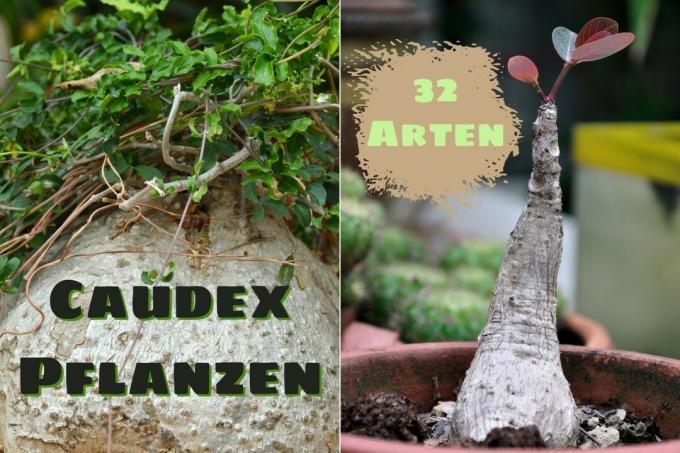
table of contents
- Types from A - C
- Types of D - H
- Plants from I - O
- Plants from P - R
- Plants from S - Z
- frequently asked Questions
A caudex plant or, more correctly, caudiciform plant, is a succulent plant that stores water in the lower trunk area. A thickened trunk or tuber is a typical feature. We introduce you to the 32 most beautiful caudex plants.
In a nutshell
- characteristic thickening of the main stem / trunk (caudex)
- serves as a storage organ for water
- succulent plants that can do without water for a long time
- take a rest phase in winter
- some species also in summer
Types from A - C
Adenia glauca
- comes from southern Africa and Madagascar
- climbing growth
- forms up to one meter thick, blue-green caudex
- grows between mid-March to mid-November
- Rest from mid-November
- Winter dry and cool at 12 to 14 ° C
Note: The characteristic thing about this caudex plant is the thick, blue-green caudex, which can measure up to a meter in diameter.
Adenium obesum
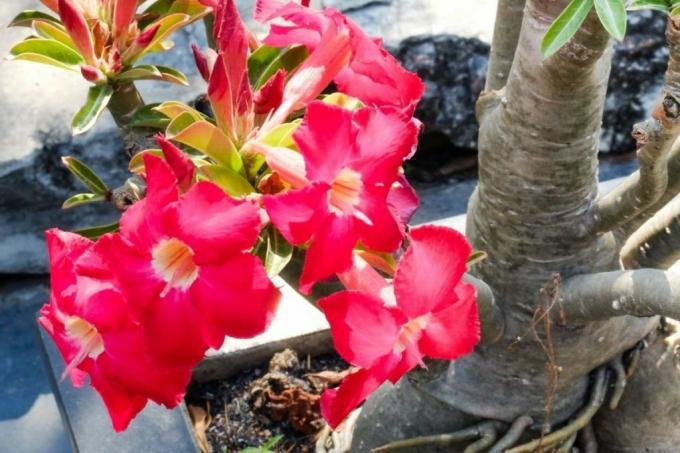
- also known as desert rose
- belongs to the dog poison family (Apocynaceae)
- exceptionally thick trunk
- Flowers in purple, red, pink and white from April to June
- undemanding and easy to care for
- needs a lot of sun
Tip: Hibernate the desert rose at around ten to 15 ° C. Basically, a warm overwintering is not a problem either, but this inhibits the bloom formation.
Albuca spiralis cv. 'Frizzle Sizzle'
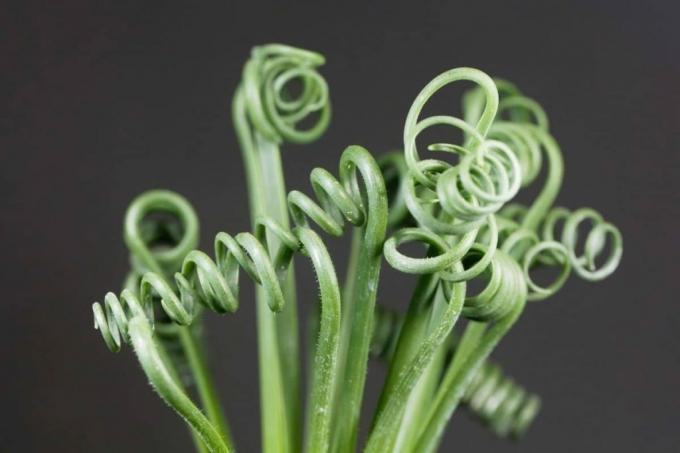
- from the hyacinth family (Hyacinthaceae)
- South African onion family
- deep green, corkscrew-shaped leaves
- fragrant, yellow flowers from June
- Location: sunny, protect from midday sun
Alluaudia procera

- native to Madagascar
- long gray and thorny shoots with small, green leaves
- Place as bright as possible all year round
- in summer at 30 ° C, in winter at at least 15 ° C
- fertilize regularly with cactus fertilizer, then grow very quickly
Ammocharis coranica
- belongs to the amaryllis family (Amaryllidaceae)
- Bulb plant with striking, pink umbellate flowers
- blooms in spring and early summer
- widespread in southern Africa
- place in full sun for optimal flowering
- Rest phase in the winter months
Brunsvigia grandiflora
- also called candelabra lily
- Flowering time in late summer
- up to 80 centimeters high inflorescence with up to 60 dark pink flowers
- comes from South Africa
- tolerates some frost
Cephalopentandra ecirrhosa
- native to East Africa (Ethiopia, Somalia, Kenya, Uganda)
- Climbing plant with tendrils up to one meter long
- Caudex up to 60 centimeters wide
- Shoots in spring, sheds the leaves in winter
- likes sun and warmth, but not blazing midday sun
- Do not place cooler than 10 ° C in winter
Note: This caudex plant is sometimes referred to as the “volcanic plant” because the thick tuber, which tapers towards the top, is reminiscent of a volcano.
Cyrtanthus spiralis
- from the family of Amaryllis family (Amaryllidaceae)
- native to South Africa
- characteristic spiral leaves
- The tuber is only three to five centimeters thick
- Rest phase mostly in the summer months
- Temperature in winter not below 15 ° C, optimally between 15 and 20 ° C
Note: This caudex species is a rarity and only rarely available in stores. Due to its rarity, the small, distinctive plant costs a lot of money at 20 to 40 EUR.
Types of D - H
Dioscorea elephantipes

- also turtle plant
- belongs to the yam family (Dioscoreaceae)
- Climbing plant from South Africa
- bizarre growth with meter-long shoots and heart-shaped leaves
- Location: sunny, dark and cool when resting
Tip: In contrast to many other plants, the turtle plant does not have fixed rest periods. She puts them in when she wants. That can be in winter or in summer. Place in the dark at a maximum of 16 ° C during the resting phase and only moisten with water once a month.
Dioscorea mexicana
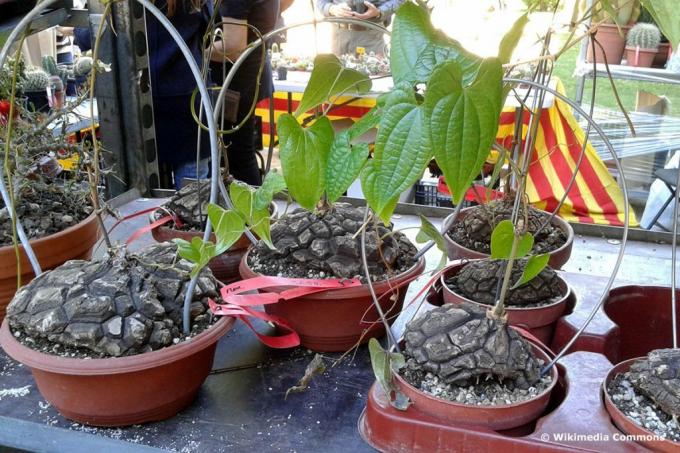
- is also known as the turtle plant
- related to Dioscorea elephantipes
- however, comes from Mexico and Panama
- Caudex can be up to a meter wide
- can live for several hundred years
- Shoots need climbing help
Dioscorea sylvatica
- also known as the elephant foot
- Rarity from South Africa
- Climbing plant with up to five meters long tendrils
- alternate, heart-shaped leaves
- Caudex up to 40 centimeters wide
Dorstenia crispa ssp. lancifolia
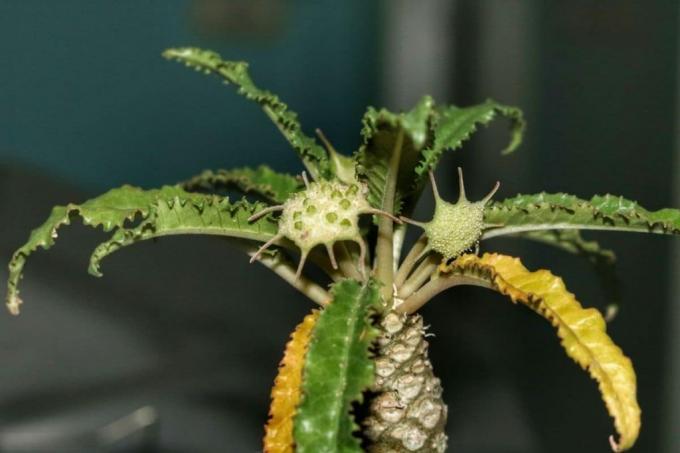
- belongs to the mulberry family (Moraceae)
- native to the Arabian Peninsula and East Africa
- tolerates midday sun
- Do not let the substrate dry out in summer
- year-round cultivation possible at room temperature
Dorstenia foetida
- German name "Stinkende Dorstenie"
- grows up to 40 centimeters high
- comes from East Africa and the Arabian Peninsula
- loses leaves in winter
- Overwinter at 10 to 15 ° C, water only sips
Dracaena draco

- also as a Canarian Dragon tree designated
- grows up to two meters high
- easy-care, evergreen houseplant
- Palm treessimilar trunk with tufts of leaves
- as bright a location as possible without direct sunlight
Tip: Turn the pot with the dragon tree regularly, otherwise the plant will grow crooked.
Eriospermum cooperi
- Asparagus from southern Africa
- Remaining small: Caudex up to seven centimeters thick
- Shade the caudex and do not expose it to direct sunlight
- single upright leaf and white to light green flowers during the summer months
- up to 60 centimeters high
Euphorbia stellata

- Small wolf plant (Euphorbiaceae) from South Africa
- star-shaped thorny branches go from the main shoot
- bright, but protected from direct sunlight
- Rest period from October to February
- ideal temperature in winter quarters: 12 to 15 ° C
Fockea edulis

- native to southern Africa
- cartilaginous, thick caudex with evergreen leaves
- forms tendrils up to four meters long
- green-yellow, star-shaped flowers in late summer
- needs full sun and warmth
- demanding in terms of care
Plants from I - O
Ipomoea holubii

- impressive, often spherical caudex
- native to southern Africa between Malawi and Botswana
- grows there in bush and grasslands
- 80 to 250 centimeters high
- pretty pink flowers
Jatropha berlandieri
- also available under Jatropha cathartica
- from the milkweed family (Euphorbiaceae)
- herbaceous plant with large, bulbous roots
- thick, fleshy shoots up to 30 centimeters in length
- Leaves up to ten inches long
- many-flowered shoots
Note: In contrast to many other caudex plants, this species is not native to Africa, but can be found in the southern United States and Mexico.
Mestoklema tuberosum
- rare species native to South Africa
- bizarre caudex with slightly flaking red-brown bark
- rosemarysimilar foliage
- up to 60 centimeters high
- bare in winter
Myrmecodia tuberosa
- is also known as the ant plant
- forms very large caudex, shoots up to 30 centimeters high
- grows epiphytically (d. H. as epiphytes), can be tied up
- Place in the shade in summer and as bright as possible in winter
Tip: In the large caudex of this species, ants live in natural habitats, with animals and plants entering into a symbiosis. In return for living space and food, the ants protect the plant from predators.
Plants from P - R
Pachypodium geayi
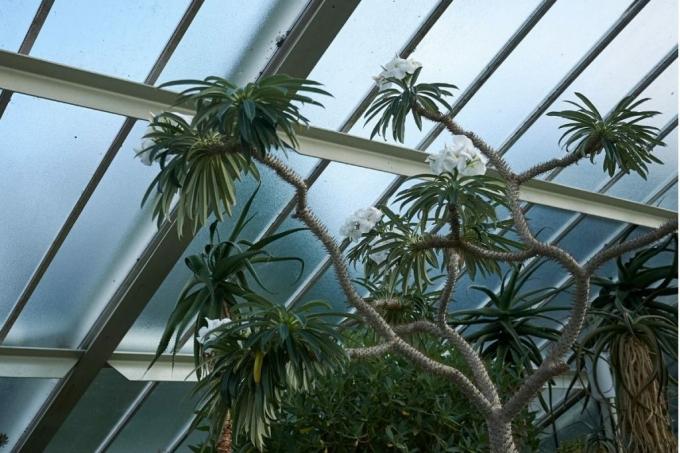
- also as Madagascar palm designated
- from the dog poison family (Apocynaceae)
- grows up to ten meters high in its natural habitat and significantly smaller in a pot
- Caudex forms thick, cylindrical columns studded with thorns
- Growth phase in winter, resting phase in summer months
Tip: In order for the Madagascar palm to grow nicely, it needs a large and, above all, deep pot that is provided with a layer of gravel. Because of the better evaporation of water, clay pots are best suited.
Petopentia natalensis
- belongs to the dog poison family (Apocynaceae)
- sometimes wrongly sold under Fockea natalensis
- from southern Africa
- Caudex with thinner. brown, torn bark
- climbing shoots lignify over time
Tip: You should water this caudex plant a lot during the summer growth phase, but avoid waterlogging. Due to the higher nutrient requirements, you should also give small doses of cactus fertilizer with each watering.
Plectranthus ernstii
- Visually reminiscent of a baobab tree in miniature
- bulbous and thickened trunk
- Leaves have a strong smell mint, therefore also as "bonsai Mint ”
- up to 50 centimeters high
- forms many white lip flowers in summer
- native to South Africa
Raphionacme zeyheri
- also native to South Africa
- forms strongly thickened, up to 25 centimeters high caudex
- up to 15 centimeters high shoots with two to four centimeters long leaves
- bell-shaped, light green flowers
- Rest phase in winter, not cooler than 12 ° C
Plants from S - Z
Scadoxus multiflorus
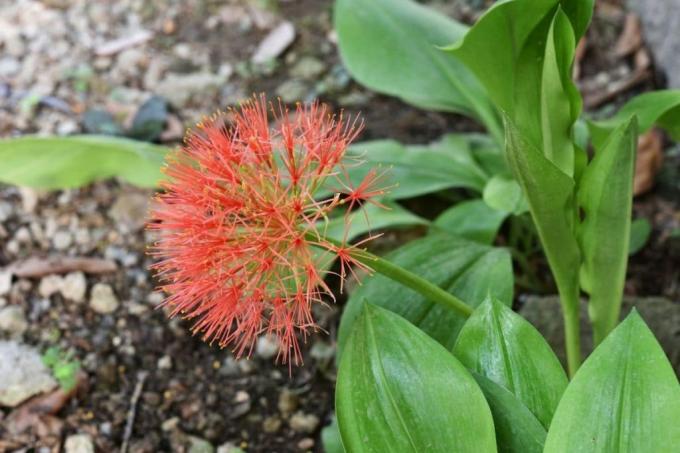
- also known as blood flower or fireball lily
- belongs to the amaryllis family (Amaryllidaceae)
- forms bright red-orange flower balls
- Flowering period between July and August
- not uncomplicated in terms of care
Tip: The blood flower feels most comfortable in a bright, but not directly sunny and as warm as possible location. It needs a nutrient-rich substrate that should be kept slightly moist during the growth phase.
Scilla violacea
- is also known as a tiger leaf
- Bulb plant with tabby leaves and flowers reminiscent of hyacinths
- The main onion sprouts many side onions
- native to South Africa
- easy to maintain
- Growth phase in summer, resting phase in winter
Stephania cepharantha v. hayata
- rare caudex plant with a caudex up to 20 centimeters wide
- native to southwest China and Taiwan
- Care: water weekly
- Winter storage: at 12 to 20 ° C, do not water
Stephania glabra
- herbaceous, perennial climbing plant with a large tuber
- large leaves
- comes from Asia, where the tuber is often used medicinally
- Care: water weekly
- Winter storage: at 12 to 20 ° C, do not water
Stephania pierrei / erecta
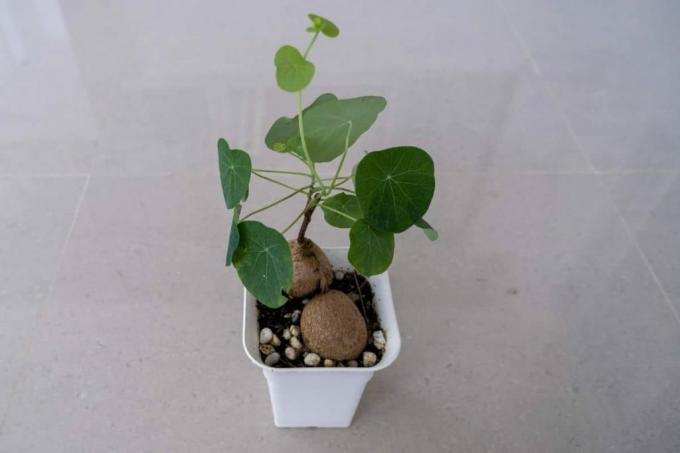
- rare caudex plant from Southeast Asia
- Caudex can be up to 30 centimeters thick
- rounded caudex
- Shoots up to eight meters long, sprout in spring
- round leaves and yellowish flowers
Tylecodon wallichii
- from the thick-leaf family (Crassulaceae)
- comes from South Africa and Namibia
- up to 50 centimeters high
- grows from mid-March to approx. Mid November
- Rest period from mid-November
- needs a full sun and warm location
Tip: Like many other summer-growing species, this caudex plant can be placed outdoors in a protected spot during the warmer months. Bring the plants in in autumn before the temperature drops below ten degrees Celsius.
Uncarina grandidieri
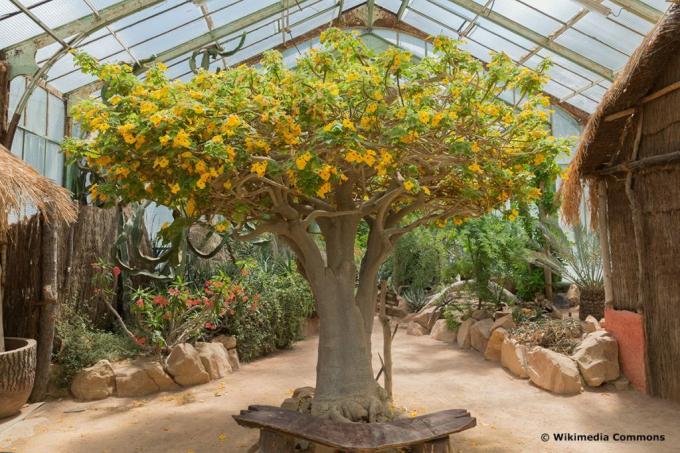
- also known as the mousetrap tree
- Caudex-forming tree native to Madagascar
- at the natural site up to four meters high
- forms bright yellow flowers
- sunny to partially shaded location in the summer months
- high water demand in summer
- Resting phase in winter: not cooler than 15 ° C, do not water
frequently asked Questions
The botanist understands the term “caudex” to mean the entire shoot of a plant, i. H. the part of the plant that grows directly from the root. It is typical for Caudex plants that this part can store water and therefore thicken considerably. Caudex plants belong to the group of succulents, whereas conversely not every succulent is a caudex.
No, under the term "caudex plant" the specialist groups plants that store water in their shoots. They belong to very different botanical families and are often not even related. The different species have only this one characteristic of their storage organ in common and with it the fact that they can do without water for a long time.
With a few exceptions, caudex plants are easy to care for: They get by with little water, require little fertilization and do not need to be cut. However, they need a lot of light and warmth, and almost all of them take a break. This is, depending on the species, in summer or in winter. Caudex plants should be kept comparatively cool and dry during their resting phase, and most species shed their leaves. You should also use a loose, permeable substrate and avoid waterlogging.



